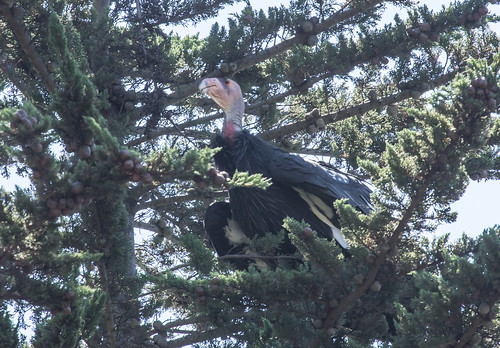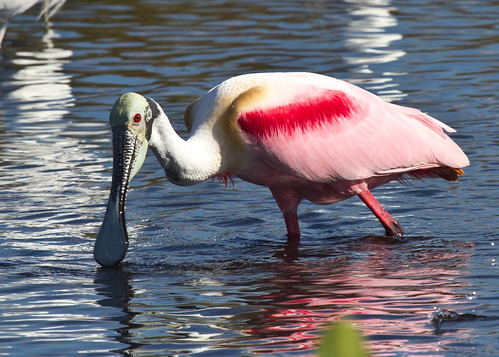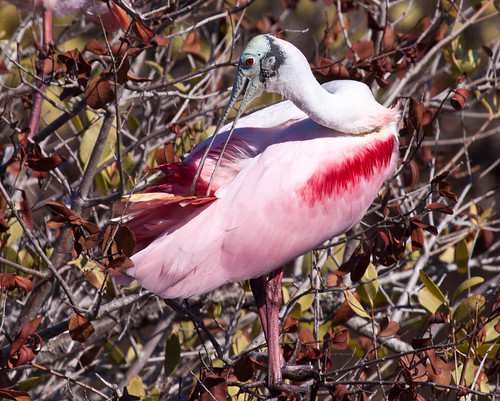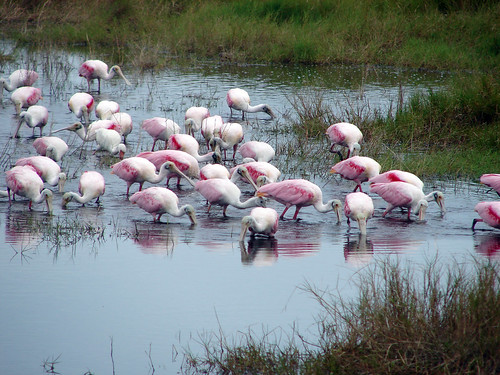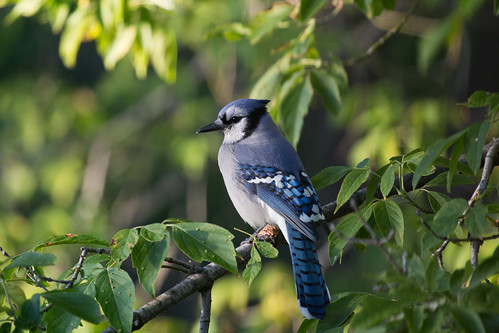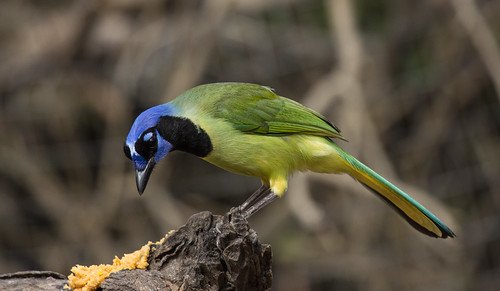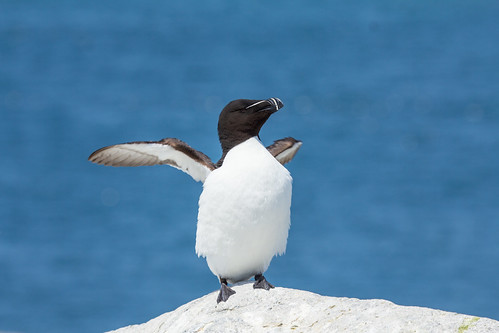
It would be very hard for me to put together a top ten list of my very favorite birds because I love so many individual species for such different individual reasons. But something about the plight of the California Condor touched my heart from the moment I learned about this extraordinary bird, consigned to a body unable to digest anything but meat, yet equally incapable of taking a life to sustain its own. (Well, condors probably swallow a few maggots here and there, but not on purpose.)
California Condors don’t have as well refined a sense of smell as Turkey Vultures do, but their extraordinary vision helps them keep track of vultures that are miles away. When vultures start spiraling down toward a carcass, condors may join in. When the vultures are dropping toward a large carcass, this is a mutually beneficial arrangement, because condors have more powerful beaks and neck muscles than Turkey Vultures do, and can tear into thick hides vultures couldn’t possibly deal with.
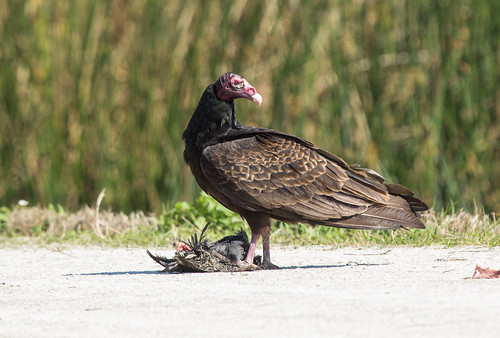
In general, Turkey Vultures, which weigh about 4 ½ pounds, prefer carcasses too small to share, and in captivity prefer fresh to decayed meals, but are sociable both in their roosts and at large carcasses. Their populations have flourished throughout their wide range as they’ve successfully adapted to feeding on road-killed animals.
Condors outweigh vultures by from 300 to 500 percent. (They weigh 15-22 pounds.) The fossil record and condor feathers found in archeological diggings show them ranging along the Pacific coast from Baja California to British Columbia, along the southern US to Florida, and up the Atlantic coast through New York, though some researchers believe that some feathers found in the East may have worked their way there via trade rather than being dropped by living condors. No matter how far their range extended before written records, it had shrunk by the early 19th century to a much more restricted area extending east only as far as western Colorado. None were spotted in Arizona after 1924, and by the 1930s, condors were restricted exclusively to California.
In 1987, with only 22 individuals remaining in the entire world, scientists discovered that every wild individual California Condor was suffering from dangerously high blood lead levels, so in a last-ditch effort to save the species, every one was trapped and taken into captivity. My friend Marge Gibson, the founder and director of the Raptor Education Group in Antigo, Wisconsin, was one of the expert rehabbers involved in the final capture of these birds—a heartbreaking task with no guarantees that condors would ever fly wild in the skies again, because condors had not yet bred successfully in captivity. Scientists theorized that condors evolved to capitalize on the huge carcasses of Pleistocene megafauna such as mastodons and giant sloths, and many comforted themselves with the belief that the species was doomed to extinction anyway.
But the loss of mastodons is hardly the cause of the species’ ultimate imperilment—we humans have been poisoning them. Even after all the work involved in breeding condors in captivity and releasing them, so that the number of birds now in the wild from reintroduction programs numbers about 226, about a quarter of the wild birds die each year, mostly due to lead poisoning. Extensive research has pinpointed the precise chemical form of the lead, verifying that the source is ammunition. Condors pick up lead shot and bullets in discarded gut piles from deer and other large game animals, from prairie dogs and ground squirrel carcasses left after farmers and ranchers shoot them, and from other shot carcasses found throughout their range. Of course, lead is dangerous to humans as well as condors. Indeed, a 2008 study by the Centers for Disease Control and the North Dakota Department of Public Health concluded that lead scatters so thoroughly in meat harvested through hunting that pregnant women and children should never eat it.
Yet the extremist NRA has fought tooth and nail to prevent lead bans over most of the condor range. Only after a huge environmental battle did California pass legislation, signed by Arnold Schwarzenegger, banning its use in 8 counties. Right now legislation that would ban its use statewide has been approved by the California Assembly, and will go into effect if Jerry Brown signs it. Meanwhile, lead shot and bullet use still flourishes in Arizona (Note that the one comment published for the linked article, to “HuntForTruth.org”, directs you to an NRA site rife with erroneous information.)
Of all the species of conservation concern I’m trying to see during my Conservation Big Year, the California Condor has been one of my highest priorities. This bird has been uniquely special to me since I learned about it during the first Earth Day in 1970. In 2011, Russ and I drove to the Grand Canyon so I could mark my 60th birthday, on 11/11/11, by seeing a condor in the wild for the first time in my life.

I devoutly hoped I’d have as much luck this year on my Conservation Big Year’s official “Day of the Condor.” The Monterey Bay Birding Festival was held from September 12-15th, and I signed up for the field trip managed by the Ventana Wildlife Society that would bring us to the best spots in the Big Sur for finding one.
California Condors weigh up to 22 pounds and have a 9½-foot wingspan, dwarfing the Bald Eagle’s 6–14 pounds and 6½ foot wingspan and the Golden Eagle’s similar dimensions.

Condors have matchless flying skills when held aloft by thermals or updrafts, but until the sun rises high enough to help those develop in mid-morning, or during foggy or rainy weather, the birds are stuck. The early birder may get the Worm-eating Warbler, but won’t usually see any condors. Our group headed for the Discovery Center of the Ventana Wildlife Society at mid-morning, where two experts, Mike and Robin, met us and explained about the reintroduction project before driving us out to California’s beautiful coastal Highway 1.
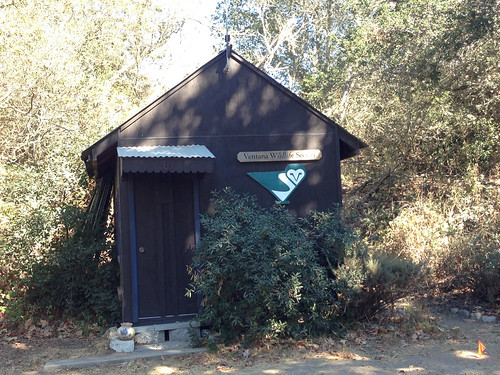
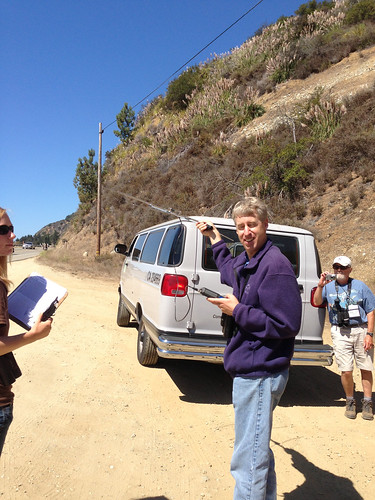
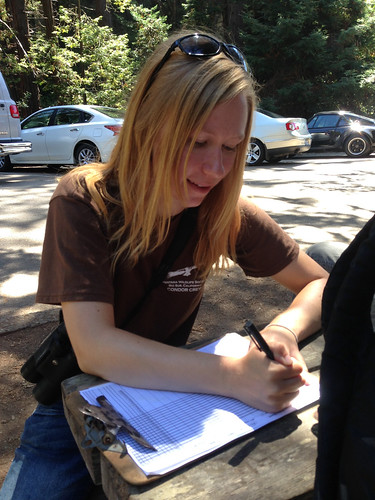
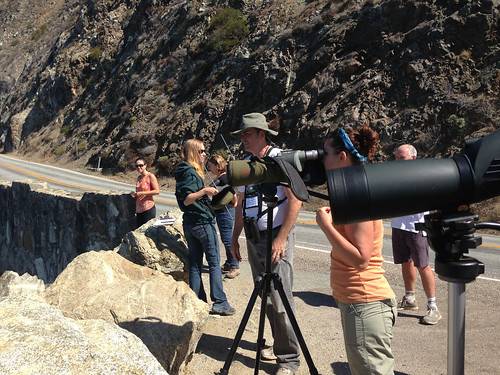
Condors often gravitate to the coast to feed on the large carcasses of marine mammals, from sea lions to whales, washed to shore. Pullouts along this busy road provide spectacular looks at the Big Sur as well as the occasional condor.
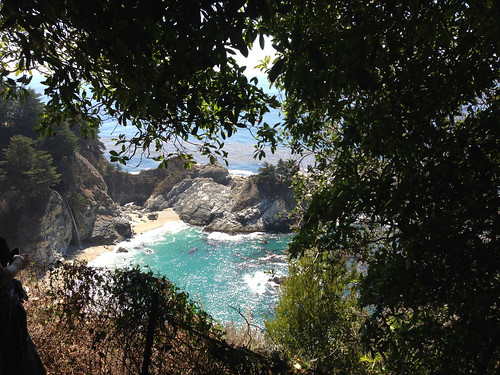
Our first stop overlooked the dramatically rugged, rocky shoreline. It didn’t take much searching to spot condors roosting off in the distance, not much further than the condors I’d seen in the Grand Canyon. I was thrilled.

After watching them for a while, we headed a bit further south on the highway, to another pullout. There, atop a Monterey cypress tree, was a condor, with a second one somewhat obscured in the branches below it. These two were so near to us that I had to pull in my 100-400 mm lens to fit them both in my camera’s field of view. I’d never ever imagined being so close to a wild condor, much less two. I can’t begin to describe my elation. They were backlit, but I didn’t even care.
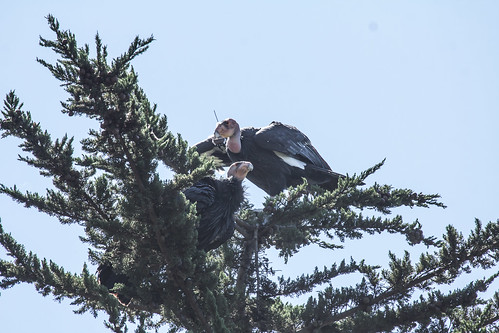
It was worrisome that the birds were so close to the busy highway, but apparently they don’t focus on roadkill—they’re merely roosting in the tall trees. Condors may have discovered that very strong thermals develop above heated pavement, and may realize that their takeoff at midmorning is easier when they’ve been roosting in a tree near a road. We savored the two for many minutes before heading further down the road.
At another pullout, we came upon another two condors roosting at the top of cypresses, these two even closer to us and both in full sun.



Now we were spotting more distant condors as well, some sitting on rocks far above us, some on rocks or trees below the road. When we couldn’t see a wing tag, our wonderful guides from the Ventana Wildlife Society used radio telemetry to work out which individuals we were seeing.


It’s sad to realize that not one condor in the wild is unmarked, and that the wildlife society must capture each individual at least once or twice each year to check its blood lead levels. Tragically often, birds require chelation treatment to get the lead out, and even with careful monitoring, annual mortality is far above what would be sustainable if captive-bred birds weren’t being released every year.
As of April 2012, a total of 405 condors existed on the planet, 179 in captivity. The Arizona wild population numbered 80, the Baja California population 21, and the California population 125, of which the Ventana Wildlife Society manages about half. It was thrilling to see at least 10 different individual condors on this field trip, and richly satisfying to hear information and stories about the individuals we were watching, but sad to hear stories about these birds’ brushes with death and the mates and young some of them had lost. It must be endlessly sorrowful and frustrating for people giving their hearts and souls to this project to hear the lies spouted by paranoid spokesmen for the NRA discounting the proven scientific conclusions about shot and bullets being the primary source of the lead that is the primary cause of mortality in these magnificent birds. And marine mammals continue to store organochlorides, including DDT, in their tissues, so eggs produced by condors feeding on whales and seals have thinner shells than is healthy. The Moonglow Dairy, a wonderful farm that allows birders on their grounds to view wetland birds, including Tricolored Blackbirds, sends stillborn calves to Ventana, which sets them out in safe areas to give the condors at least one uncontaminated food source. Like the condors themselves, the wildlife managers and helpful volunteers get up each day and do what needs to be done without writing off condors as doomed before their time. These quiet heroes understand that every lost condor diminishes our nation and our planet.
When the weather isn’t perfect, or if the condors aren’t hanging around the coast, they can be tricky to find even with radio telemetry, so my Day of the Condors, when we saw at least 10 different individual condors, was exceptional. Many people manage to find condors on their own by driving along the right stretch of Highway 1, watching for condors, sometimes aided by the flocks of birders and photographers that gravitate together, their spotting scopes and large cameras pointed at condors. If you find yourself in California, I recommend attending at least one condor tour by the Ventana Wildlife Society. Your $50 fee helps sustain the work of this splendid organization, ensuring that we, our children, and our children’s children will be able to enjoy this amazing spectacle long into the future.
As of today, September 20, 2013, I’ve seen condors on exactly 2 of the 22,594 days I’ve been alive. Just knowing that condors are out there has been important to my peace of mind and overall happiness during the 15,890 days since I first learned of their existence on Earth Day 1970. And the moments I’ve spent with condors in the Grand Canyon and now California have burnished my memory with a glowing luster that will last a lifetime.
Some of the individual birds we saw on September 15:
#534, Female hatched May 18, 2009 at the Oregon Zoo.

#167 “Kingpin,” male hatched May 6, 1997 at the LA Zoo.

#418, Female hatched May 10, 2006, at the LA Zoo.

#351, male hatched May 28, 2004 at the LA Zoo
